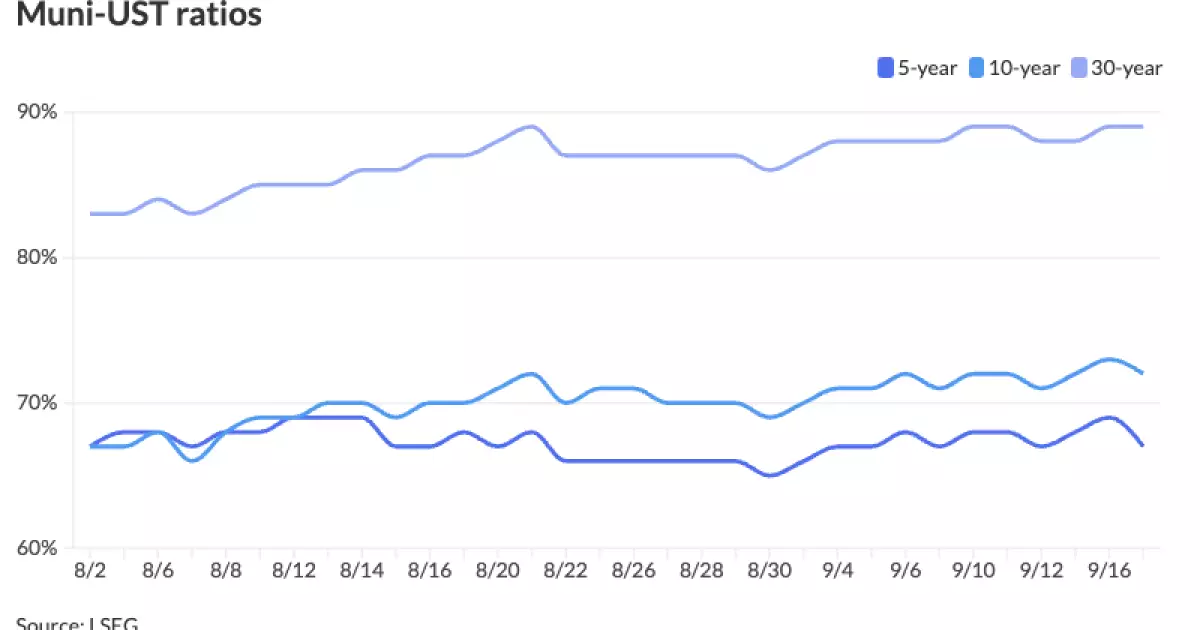The municipal bond market is currently displaying a mix of stable to slightly appreciating prices, especially observed in specific segments. Recent pricing of large new issues coincides with a retreat in U.S. Treasury yields, and market participants are bracing for the Federal Open Market Committee (FOMC) rate decision that is slated for Wednesday. Many analysts, including Cooper Howard from Charles Schwab, assert that a Federal Reserve rate cut appears inevitable; however, the extent of this potential reduction remains a subject of contention. Howard indicates that any cuts could catalyze a positive response in both taxable and tax-exempt bonds. With current nominal yields still markedly higher than during previous dovish settings by the Fed, there exists a significant opportunity for recovery.
Despite these positive indicators concerning potential Fed actions, municipal bonds have been lagging behind their U.S. Treasury and corporate counterparts. According to Howard, tax-exempt munis are yielding a mere 2.04% year-to-date, in stark contrast to UST and corporate returns of 2.98% and 5.87%, respectively. This underperformance raises critical questions about the underlying valuation dynamics within the municipal space. However, Howard also highlights the silver lining: relative valuations have improved. The two-year municipal-to-Treasury ratio has markedly shifted, with figures like 65% for the two-year and 72% for the ten-year bonds, suggesting that municipalities are becoming comparatively more attractive than they have been in the recent past.
Despite this gradual improvement in valuations, analysts from Municipal Market Analytics are advising caution. The noticeable underperformance of tax-exempt municipals, especially in 2024, when compared to USTs and taxable munis, raises alarms. As noted by Matt Fabian, the reluctance of certain fund flows to migrate away from safe havens like money market funds poses an added challenge. There is uncertainty surrounding how aggressively income-oriented strategies will engage in tax-exempt yields, particularly in favorable market conditions. Observers will likely remain on the sidelines until there’s a clearer picture following Federal rate reductions.
Turning to the primary market, we see significant movement with several notable new issues. J.P. Morgan recently priced $476.585 million in electric system revenue bonds for the Jacksonville Electric Authority, which showed a range of competitive yields, including 2.57% for 2025 maturities. Meanwhile, the Bank of America Securities facilitated the issuance of various bonds, from $151.12 million in revenue refunding bonds for the Public Power Generation Agency to $143.39 million in taxable sustainable development bonds for the New York City Housing Development Corporation. Such transactions underscore the continued interest in municipal offerings despite the prevailing uncertainties.
As for the interest rate environment, adjustments to municipal yield curves were evident across different ratings and maturities. For instance, the Refinitiv MMD’s scale showed slight increases across the spectrum, with the one-year noted at 2.50% and the ten-year at 2.63%. Similarly, ICE Data Services reflected modest adjustments, indicating a generally stable yet responsive yield curve. Notably, Treasuries exhibited slight improvements as well, with two-year UST yields reaching 3.589%. Such parallels in both market types suggest a synchrony of sentiment as market participants adjust to anticipated shifts in monetary policy.
Looking ahead, the pipeline remains robust with several issuances set to enter the market. The Allegheny County Sanitary Authority plans to issue $360.46 million in sewer revenue refunding bonds, while the Washington State Housing Finance Commission is preparing for its own municipal social certificates. Additionally, the Industrial Development Authority of the City of Yuma is lined up for significant hospital revenue bonds. Such upcoming activities signal sustained interest and participation in the municipal bond market.
The municipal bond market is currently navigating through a phase of cautious optimism. The backdrop of expected Fed rate cuts combined with emerging favorable valuations provides a compelling narrative for investors. However, continued underperformance compared to alternatives necessitates a measured approach. Investor sentiment will likely hinge on forthcoming economic data and Federal rate decisions, creating a landscape where patience—rather than haste—may be the best strategy for those looking to engage within this asset class.

